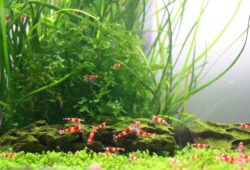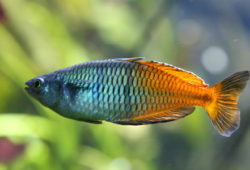The Japanese Spotted Anthias in the Aquarium
In the article I share what I learned about The Japanese Spotted Anthias in the Aquarium. While not inexpensive, this small deepwater anthias species is one of the most beautiful fishes the marine aquarist can keep with relative ease in a saltwater aquarium.

The Japanese spotted anthias (Odontanthias borbonius), also commonly called the yellow-spotted anthias and the checked swallowtail, is a beautiful fish that is highly sought after by serious marine aquarium hobbyists. Although not a beginner fish (anthias species seldom are) this marine fish is one of the easier-to-keep anthias, although it is expensive. With the proper system and husbandry, any intermediate to advanced aquarist should have no problem keeping this fish.
Contents
Japanese Spotted Anthias Natural History
The Japanese spotted anthias only reaches about 15 centimeters in length and is known to inhabit deepwater (to 300 meters) subtropical reefs around southern Japan. It has also been observed in the tropical and subtropical Indo-Pacific from South Africa to Palau and northern Indonesia.
A Justifiably Expensive Saltwater Aquarium Fish
Blue Zoo Aquatics, a Los Angeles-based online retailer of marine aquarium animals, imports this fish when it is available. Mark Martin, director of marine ornamental research at Blue Zoo and author of The Complete Idiot’s Guide to Saltwater Aquariums explains why this fish often sells for $250 or more.
“These are a deep water anthias,” he says, “and they are most frequently imported from Japan and northern Indonesia where they come up to as shallow as 60 meters seasonally. The seasonal nature of the fish’s availability, combined with the depths at which it is collected, drive up the price, but it is truly one of the most beautiful fish an aquarist can keep.”
Japanese Spotted Anthias Husbandry
The appropriate husbandry for the yellow-spotted anthias is similar to the husbandry of other anthias species. Most important, this fish must be fed frequently, as it is very active. Ideally the yellow-spotted anthias will be able to feed continuously on zooplankton, as it does in the wild, but because the available supply of zooplankton is far less in the aquarium, the aquarist must make-up for the deficit with multiple feedings each day. The addition of a mature refugium plumbed to the display tank housing the anthias is perhaps the best way to appropriately care for this fish.
If a refugium is not available, this fish should be offered a varied diet of small meaty foods at least three times per day. Most anthias will also readily accept commercially prepared frozen, pellet and flake foods.
Social Aggression
It is important for the aquarist to also understand the social behavior of this fish in order to properly care for it. The Japanese spotted anthias is a protogynous hermaphrodite, and keeping a shoal together in the aquarium can be a recipe for disaster if careful planning and observation are not undertaken. A group of these fishes housed together in all but the largest systems will cause aggression. The best advice is for most aquarists to only add one member of the species to their tank.
This fish is best kept with other peaceful community fishes. In most cases, the Japanese spotted anthias will leave sessile invertebrates alone, although adults are known to hunt and prey on ornamental shrimp.
Environmental Considerations
The anthias aquarium should have plenty of live rock to promote biological filtration and zooplankton populations. A robust filtration system with excellent protein skimming is a good idea given the frequency with which these fish must be fed. Stable water quality and as stress-free an environment as possible will go a long way to preventing both bacterial and protozoan infections to which this fish is prone.
Because this is a deepwater species, high intensity reef-ready lighting is not ideal, although with time, most Japanese spotted anthias will become acclimated to the bright lights.
Finally, it is essential to cover an aquarium housing this fish, as they are known jumpers.



